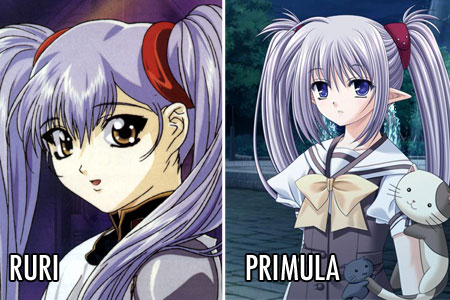Ask John: Why Do Some Anime Characters Look Similar?

Question:
I can’t help noticing that Shuffle’s Primula bears a rather close resemblance (at least facial) to Martian Successor Nadesico’s Ruri Hoshino. Might this be a rare case of “homage” that, on another occasion, would have been called out as a case of plagiarism? Or is it that some character designs might be so endearing that they re-appear even years after their first appearance? And are you aware whether this has happened elsewhere in anime?
Answer:
One of the frequently cited explanations for the use of unnatural hair colors in anime is to enable distinctions between characters. The breadth of anime proves the creative ability of Japanese artists to create character designs that adhere to a recognizable Japanese pop art aesthetic but exhibit distinctive variety. However, with the sheer number of existing anime characters, the prolificacy of certain character designers, and the fact that hand drawn art doesn’t have the minute distinctions and details that the human eye is capable of perceiving, naturally certain characters will appear to resemble other characters. These sort of similarities are common in the work of singular artists. Hayao Miyazaki’s Fio Piccolo is often cited as a twin for Nausicaa. Rumiko Takahashi’s Kasumi Tendo and Kyoko Otonashi could pass for twin sisters. And Rouran from Kikou Sennyo Rouran is virtually a reincarnation of director Toshihiro Hirono’s earlier super powered heroine Iczer-One. But merely pointing out consistency in particular artists’ illustration styles doesn’t address the inquiry.
Without knowing exactly what character designers were thinking, it’s difficult to conclusively state that particular characters or character designs are intentional homages to earlier characters. In some cases, the similarity may be intentional. In other cases the similarity may be caused by unconscious influence. I think the later case applies to the visual similarity between Ruri Hoshino (particularly her appearance in the Nadesico movie) and Shuffle’s Primula. The thin, lithe body and long grey pony-tails are certainly similar between the two girls, but their personalities are entirely opposite. Similarly, I’ve long thought that Rei Kuki from Genji Tsuushin Agedama looks like Lum with a slightly different hair style. And Keroro Gunso’s Natsumi Hinata reminds me of Kanko Shirai from Tsuideni Tonchinkan in both appearance and personality. But I think that these similarities are primarily coincidence.
On the other hand, a number of parallels come to mind that do seem like more than pure chance. Although their appearances aren’t immediately evidently similar, Ruri Hoshino may be an inspiration for Chika Yurikasa from Asagiri no Miko, who is also small, with pony-tails and an acerbic tongue. Both the appearance and personality of Happy Lesson’s Kisaragi Ninomai seem obviously based on Evangelion’s Rei Ayanami. In fact, Ninomai could be called an adult version of Ayanami. Yoko Tanaka from 1990’s Idol Tenshi Youkoso Yoko was a transforming idol singer with pink hair tied in pony tails high on her head. Shiratori Nagisa from 1994’s Chou Kuseninarisou was also a transforming idol singer with large pink ponytails. This particular magical girl appearance seems to have resurfaced for a third time in 2007 as “Cure Dream” in the Yes! Precure 5 series. Traditional Japanese women skilled in swordplay often have typically Japanese dark, long, straight hair and a stoic personality. Outlaw Star’s Twilight Suzuka resembles Negima’s Setsuna Sakurazaki while Maburaho’s Rin Kamishiro is especially similar to Sister Princess’ Haruka.
In some cases, such as Kisaragi Ninomai seeming to be obviously an homage to Rei Ayanami, the similarity is created for comic effect. More often, I think that certain visual characteristics are consistently used because they naturally evoke certain impressions. Pink “twin tails” seems a natural fit for energetic, optomistic, outgoing magical girls. Class representative girls like ToHeart’s Tomoko Hoshina and Kanokon’s Akane Asahina, and Kannagi’s art club chairman Takako Kimura, typically wear glasses. So rather than think of these similarities as plagiarism, or even, in some cases, homage, in certain cases visual similarities between anime characters are part of the unspoken language of anime; a visual cue used to provide extra characterization subtly.
Add a Comment
You must be logged in to post a comment.


>director Toshihiro Hirono’s
Hirano, I think.
I think part of it is the lack of imagination, and part of that is the cheapening of costs of anime due to the non-realization of expected return on investment.
Honestly, I think characters are copied all the time in anime. If a character is popular then shameless writers will copy them without a moment’s hesitation. Sad, but that’s how it goes.
On a somewhat relevant note, has anyone else noticed that many anime today are very unoriginal and you are starting to watch older anime to satisfy yourself?
well, why do people look so much alike, there is a limit and actualy these pictures do not have that much in commen lol just because hair is same color with the red cirle things, the face is diffrent, the hair in its self is diffrent, the eyes very little in commen, but i gues at maybe a glance they could look alike